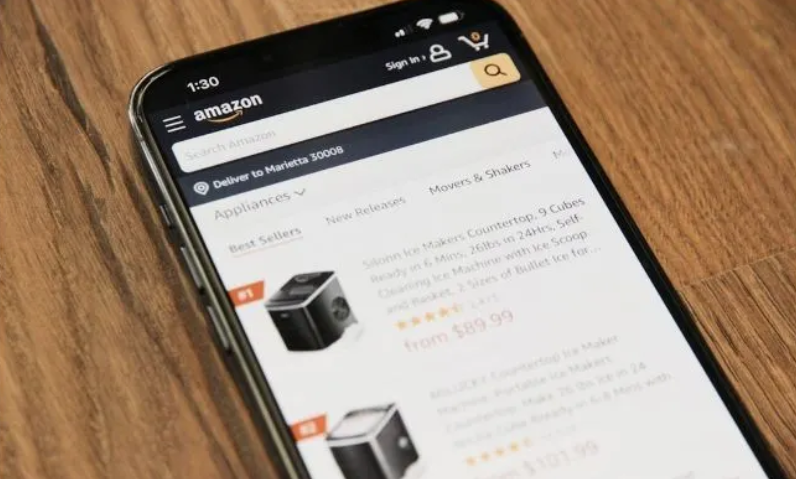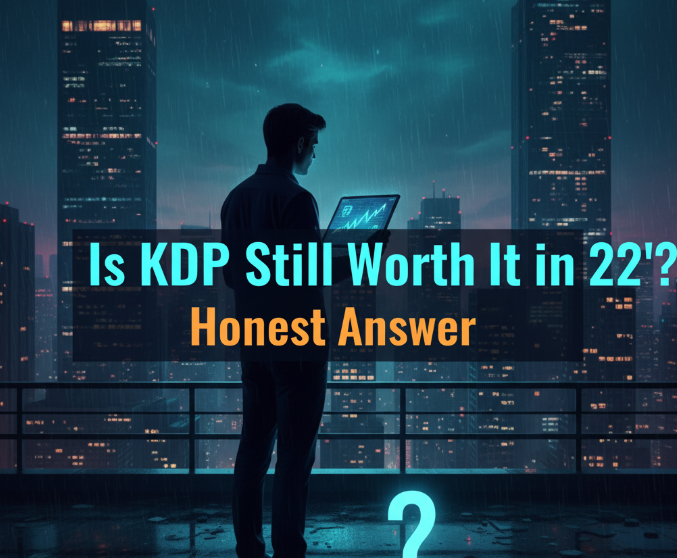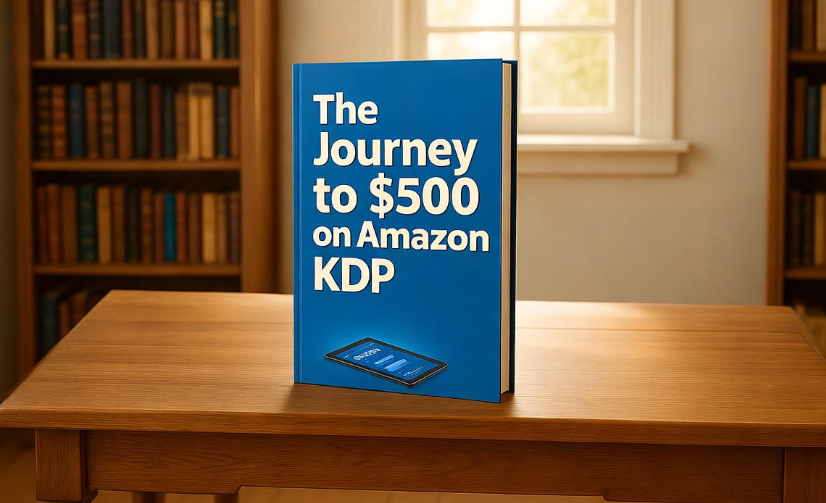You might have heard the success stories of people publishing books on Amazon KDP making thousands of dollars. Perhaps you have even heard the market is “dead” or “too saturated.” So what’s the real deal? Is Kindle Direct Publishing a gold rush or should you dust off your pickaxe and look elsewhere?
Let me just say it like it is: Yes, KDP is worth it in 2025 but not like how it was five years ago. The game has changed. The days of easy money are over, but there are real opportunities for those who will adjust and actually work.
In this post, I’m going to dive into the full scoop of what you should know about KDP in 2025—both the good and bad and the strategies that still work right now.
What’s Changed For KDP in 2025?
Kindle Direct Publishing, Amazon’s publishing platform, hasn’t experienced a fundamental transformation. You can still add a book for free and be selling within 24-48 hours. But the ecosystem around it? That’s a completely different story.
The Competition Got Serious
Five years ago, you could just slap up a simple book and make some good money. Today, customers expect professional-quality content. We’re talking about:
- Superior, traditional publishing-like covers
- Content edited free from spelling, punctuation & grammar mistakes
- Good formatting everywhere
- Information that readers can use
The bar has risen dramatically. Lazy books tend to get buried or pulled by Amazon’s capricious content clamps.
Amazon’s Algorithm Changed
Amazon now runs the first 30 pages of a book — not enough to finish in many cases, but enough to indicate how likely you are to continue reading. They track metrics like:
- How many pages readers actually read (KENP through Kindle Unlimited)
- How frequently do strangers put down your book
- Reviews and ratings
- Return rates
- Click rates in your book listing
Which is to say that you can’t just publish and forget. Your book must provide genuine value, or it won’t get endorsed to potential readers.
More Authors, Same Readers
Books published on KDP have exploded, but the number of readers has not expanded in kind. This further crowds the field for the same set of eyeballs.
The Real Numbers: How Much Can You Really Earn?
Let’s talk money. I am going to let you know what is reasonable according to the current data.
| Author Level | Monthly Income Range | Books Published | Work Involved |
|---|---|---|---|
| Beginner (First 6 months) | $0 – $100 | 1-5 books | Steep learning curve |
| Intermediate (6-18 months) | $100 – $1,000 | 5-20 books | Regular publishing |
| Advanced (18+ months) | $1,000 – $5,000 | 20-50 books | Smart backlist |
| Professional (2+ years) | $5,000+ | 50+ books | Full-time career |
These are if you’re publishing in good niches with decent research. Choose wrong niches or write bad content and you never make any money no matter how hard you work.
Where the Money Really Comes From
Most successful KDP authors are not earning off one book. They make it from:
- A few books that make $50-$300 a month
- Series in which readers pull their wallets from their pockets again and again
- Kindle Unlimited page reads (which usually amount to 40-60% of the income)
- Sales of backlist from titles published many years ago
Let alone one book that is generating you $10k a month. Twenty books each earning $500/month? That’s more common and achievable.
What’s Working Right Now in 2025
Forget what worked in 2020. This is what sells today:
Fiction Still Dominates
Romance, mystery and fantasy breathe down their necks. Why? People read these for entertainment, and people binge series. A solid first book translates into automatic sales for books 2, 3 and beyond.
Current hot niches:
- Cozy mysteries
- Paranormal romance
- LitRPG (gaming-based fantasy)
- Post-apocalyptic survival
- Contemporary romance
Non-Fiction Needs Specificity
Generic non-fiction books get ignored. “How to Make Money” is not going to sell. But “How to Start a Pressure Washing Business in 2025” is primed for success.
The more targeted and niche your non-fiction, the better. Consider solving one problem really well for one type of person.
Low-Content Books Face Challenges
Journals, planners and coloring books still remain in KDP but are no longer easy pickings as Amazon really tightened the screws. You need:
- One of a kind interiors (NOT cookie cutter templates)
- Professional covers
- Proper niches (not oversaturated)
- Consistent publishing
The dream of “publish 100 notebooks and make passive income” is dead. But well-researched, high-quality low-content books in a few specific niches can still be effective.
Master keywords with this Complete KDP Keyword Research Guide.
Audiobooks Are Growing
Integrate with ACX (Audiobook Creation Exchange) to transform your KDP books into audiobooks. This is expanding faster than ebooks, and there’s less competition.
If you have popular KDP books, audiobook editions can increase your revenue 20-40% with little additional effort.
The Biggest Challenges You’ll Face
I’m not going to mince words about it. Publishing on KDP in 2025 will present real challenges:
Challenge #1: Standing Out
In a world in which there are too many books on Amazon, standing out is brutal. You need:
- Ad budget (AMS ads are no longer optional)
- Great cover design that gives scrollers pause
- Attention-grabbing book description that turns browsers into buyers
- Strategic keywords that get you discovered
So many newbies drop out because they don’t budget for these must-haves.
Challenge #2: Time Investment
It takes a while to make a great book:
- Research: 10-20 hours
- Writing: 20-60 hours (if longer)
- Editing: 10-20 hours
- Cover design: 5-10 hours ($50-200 if outsourced)
- Formatting: 2-5 hours
- Marketing: Ongoing
We’re talking 50-100+ hours per book at absolute minimum. If you aren’t prepared to put in that amount of work, you’re going to fail.

Challenge #3: The Learning Curve
You need to learn:
- Niche research and keyword tools
- Cover design principles
- Amazon’s ranking algorithm
- Advertising strategies
- Email marketing basics
- Book formatting
- Amazon’s constantly changing policies
It takes months to learn this. Most give up before they have a chance to experience success.
Challenge #4: Upfront Costs
If it’s “free,” what is KDP going to cost you?
- Editing: $100-$500+ per book
- Cover design: $50-$300 per book
- Software/tools: $20-$100 per month
- Advertising: $100-$500+ per month
- ISBNs: $0-$125 (you don’t need one, but will look more professional)
Books will cost at least $200-$500 per book for professional quality.
Smart Strategies for 2025 Success
If you’re still reading, you mean business. Here’s how to actually succeed:
Strategy #1: Pick Your Lane
Don’t try to publish everything. Pick a niche or genre and be the one people see as its face. This helps you:
- Build a loyal reader base
- Learn one market deeply
- Produce series that result in residuals
- Become more efficient at writing
Strategy #2: Quality Over Quantity
One great book is worth 10 mediocre ones. Focus on:
- Thorough research
- Professional presentation
- Real value for readers
- Proper editing
There’s only one road to sustainable income in 2025: quality.
Strategy #3: Build a Series
The money is in series. You can price your first book at $0.99 as a reader hook, or even free. So books 2-5+, that’s where you get to the profit.
Your book one completers will often go on to purchase the whole series. This creates a compounded effect on your earnings.
Strategy #4: Master Amazon Ads
Organic discovery is tough. Most successful writers use 30-40% of their earnings on Amazon advertising. Learn to:
- Create profitable ad campaigns
- Keep an eye on your ACoS (Advertising Cost of Sale)
- Test different keywords and targeting
- Scale what works
Have a minimum ad budget of $5-$10 per book/day when starting out.
Strategy #5: Grow Your Email List
Amazon has your customers, not you. Build an email list to:
- Announce new releases directly
- Reduce dependence on Amazon’s algorithm
- Create loyal superfans
- Have a backup if Amazon changes rules
Employ a lead magnet (free first book) to get readers onto your list.
Comparison: KDP vs. Other Publishing Options
Let’s take a look at how KDP compares to other options:
| Platform | Pros | Cons | Best for |
|---|---|---|---|
| Amazon KDP | Massive audience, easy to do, fast paying | High competition, Amazon has all the control | First time authors |
| Traditional Publishing | Professional support, prestige, bookstore distribution | Takes years, lower royalty | Established author with agent |
| Draft2Digital | Large distribution pool, easy to use publishing system | Smaller than Amazon income | Premium publishing |
| IngramSpark | Print books available for bookstores, good quality print | Costs money, complex setup | Print-focused authors |
| Patreon/Substack | Direct reader relationship, provides recurring money | Must focus on building up your base | Serialized content creators |
For the majority of authors, KDP is still the best place to start since you get Amazon’s huge customer base and no upfront costs for publishing.
Who Should Try KDP in 2025?
KDP isn’t for everyone. It’s worth it if you:
✅ You’re a Good Fit If You:
- Love to write or can hire ghostwriters
- Have $500-$1,000 to invest upfront
- 6-12 month commitment to work before profits can be realized
- Like learning marketing and data analysis
- Want to create an asset for the long term
- Have patience for slow growth
- Enjoy the creative process
❌ Skip KDP If You:
- Need fast cash (get a job instead)
- Won’t invest money in quality
- Expect one book to make you a millionaire
- Hate marketing and promotion
- Can’t take rejection (bad reviews are part of it)
- Won’t take time to understand the business
- Just want “passive income” with no work
The Verdict: Should You Use KDP?
Here’s my straight-shooting take: Yes, but only if you treat it as a bonafide business.
Easy passive income on KDP is dead. What works now is:
- Publishing high-quality books consistently
- Investing in professional presentation
- Learning advertising and marketing
- Building a backlist of 10-20+ books
- Treat it as a business in the long run, not just a lottery ticket
Can you earn $1,000 a month after one year? Totally, if you play your cards right. Can you retire in six months? Probably not.
The Real Opportunity in 2025
Yes, the competition has increased, but also the tools and resources. You have access to:
- Better AI support for research and editing
- More affordable design services
- Advanced advertising platforms
- Better analytics and tracking
- Huge audiences in underserved niches
The winners in 2025 are authors who can marry being creative with having a knack for business. They are writers who think like marketers and entrepreneurs.
My Recommendation
If you’re considering KDP, make it happen under the following terms:
- Start small: Publish 1-3 books before you go full tilt
- Budget well: You need to have money for editing and covers, ads etc.
- Always be learning: Take classes, read blogs, network
- Set realistic goals: Begin with $500/month as your goal, you can begin to extend once comfortable
- Monitor everything: Gauge your success where it counts
Give yourself 12 months to see if it’s what you want. That’s enough time to write a few books, learn the business and make some sales.

Frequently Asked Questions
How much money do I need to publish on KDP?
You could start a book at $0, but you’ll want to budget $300-$500 for your first book, after the cover and editing and having a bit set aside for promotion. If you are serious, have $1,000-$2,000 for your first 3-5 books.
How long does it take to make money on KDP?
Most will start making good money (we’re talking about $500-$1,000 per month) in 6-12 months. You need time to put out multiple books, learn about advertising and gain some traction. Do not anticipate being profitable in your initial 3 months.
Can one still make money with low-content books?
It’s a lot more difficult now, but is still feasible within certain niches. The designs have to be really unique and you really can’t depend on simple templates. Most low-content publishers who are successful have hundreds of books and treat it like a full scale business.
Must I join Kindle Unlimited?
The majority of indie authors sign up for KU (Kindle Unlimited) because there they make between 40-60 percent from page reads. But it means working with Amazon exclusively. Test both enrolled and not-enrolled to see what works well in your genre.
How many books do I have to write until I make $1,000 a month?
This varies enormously by genre and quality, but a good estimate is 10-30 books. Some succeed with a smaller number of books by having strong series. Others require 50+ books but at a lower income per book.
Which is more profitable, fiction or non-fiction?
For fiction, you have larger volume readers and stronger series potential. Non-fiction has the potential to get higher prices and can be easier if you are good at it. Both are profitable so pick and choose based on your interests or skills.
May I use AI to write KDP books?
You can use AI as a research, outlining and editing tool, but Amazon asks that you let people know it’s AI generated. Books clearly written by AI without any human editing get bad reviews and don’t sell. Deploy AI as an assistant to human creativity, not a substitute for it.
What genre is easiest for beginners?
Romance and thriller actually have established markets with very distinct reader expectations. “How-to” non-fiction books in certain niches also do well. Avoid tackling a competitive niche (like the saturated self-help or high-fantasy sections), unless you can bring something new to the table.
How can I promote my KDP book without an audience?
Begin with Amazon Ads (AMS), which shows your book to people who are already shopping for similar books. Build your email list from day one. You might also want to put it on a free promotion at first to get some initial reviews and visibility. Join reader groups in your genre to know your audience.
Will AI and ChatGPT destroy the KDP market?
AI is a tool and it makes some things easier, but readers still want good stories and valuable information. The writers who employ AI well but combine it with human creativity and quality will succeed. Those seeking to spam low-quality AI content will fail more quickly than ever.




